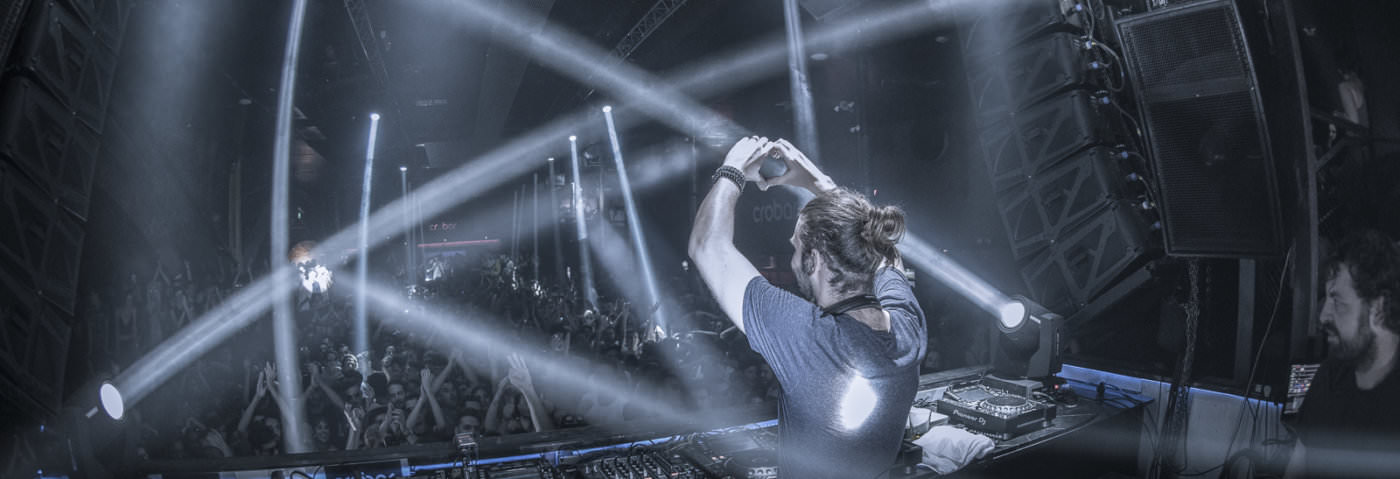This month’s My Studio feature is with Netherlands-based producer Eelke Kleijn, a multi-instrumentalist and composer who has scored a number of films and video games in addition to producing a substantial techno and progressive house discography. He’s just dropped his new album ‘Oscillations’ so we took the opportunity to take a look around his studio.
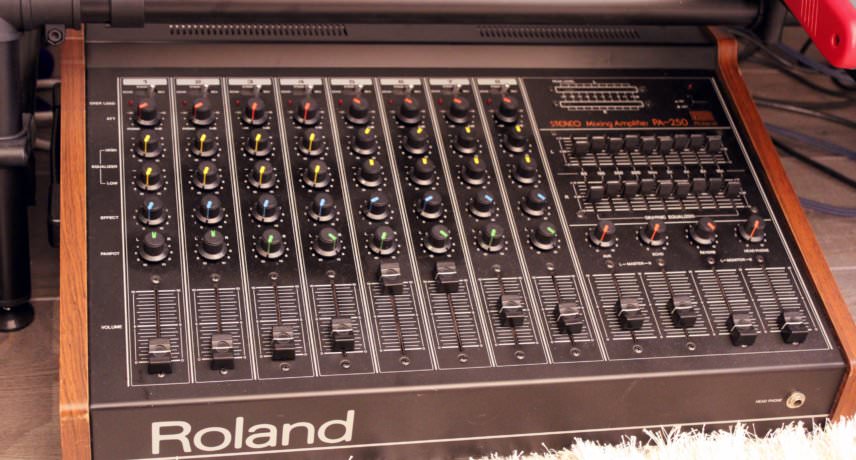
Roland PA 250
I came across this mixer just randomly browsing a Facebook studio gear group that I am part of. I did not know it before then, but it drew my attention because it has a real spring reverb built-in. I love the sound of spring, and before the PA 250 I only owned digital recreations. I basically bought it without reference, but what I was hoping for was maybe setting it up as a send return from my DAW and spicing up some cold and lifeless sounds. Turns out that I was right!
It’s set up in such a way that I am always driving the gain circuit and there’s always a bit of spring and EQ on everything that I send through. It’s especially amazing on drum loops, I hate going through all those cold and sterile sample libraries with countless loops, but previewing them through this thing is a joy. It just adds life to everything you throw at it. Don’t expect squeaky clean, it’s noise, dirt and hum, but that is exactly what I love about it. I’ve used it on a couple of tracks on the new album. For instance, the bass line in Control was sent through it in its entirety. You can hear the spring quite well right at the start of the tune when the bass fades in, and you can hear the noise and spring fade out right at the end at 5:43. I also used it for all the rhythm parts in Tide. They come in at 1:48.
Because it adds a bit of noise and low-frequency hum every time you send something through it, I prefer to send a couple of tracks at once, once they are mixed well. You don’t want all of that noise adding up. I don’t think it’s the most versatile piece of gear that I own, but you can’t really put a price on inspiration, and that’s one thing that the PA 250 does really well!
Related
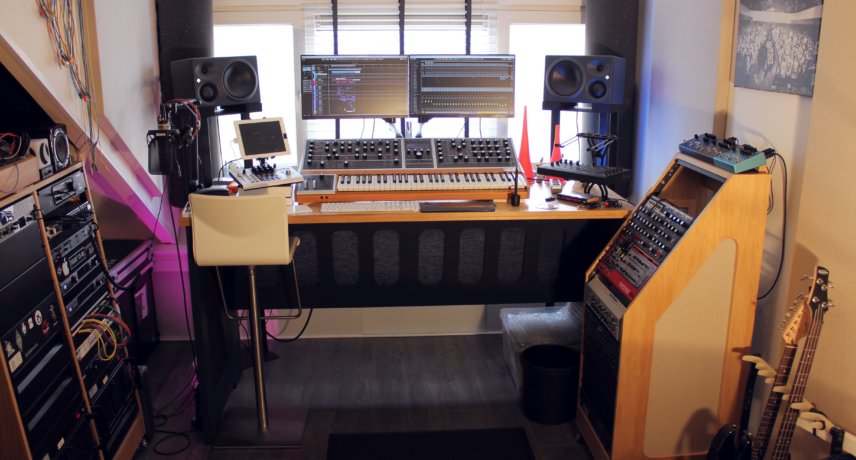


Overview
I built my current studio into the attic of my house back in 2016. After struggles with RSI and neck issues, I changed the whole setup into a standing workspace. I thought about having a desk that moves, but it just seemed too much of a hassle with speakers and cables having to move as well, so instead I added a custom height bar stool and I alternate between standing up and sitting down. I also changed to a mobile setup a few years back, so I am now running everything from a Macbook Pro. When I’m travelling I can work on tracks on the go, and at home, it goes into a thunderbolt dock and I can work with all my external gear. Even though you don’t really see it, a lot of acoustics went into this space. There are 3 room height bass traps behind me, and the entire ceiling is cloth with treatment behind it. Together with the panels that are left and right of my listening positions, the room sounds remarkably balanced and neutral for its size. I’ve always found acoustics extremely important, I can’t work at all if the sound is no good.
Related
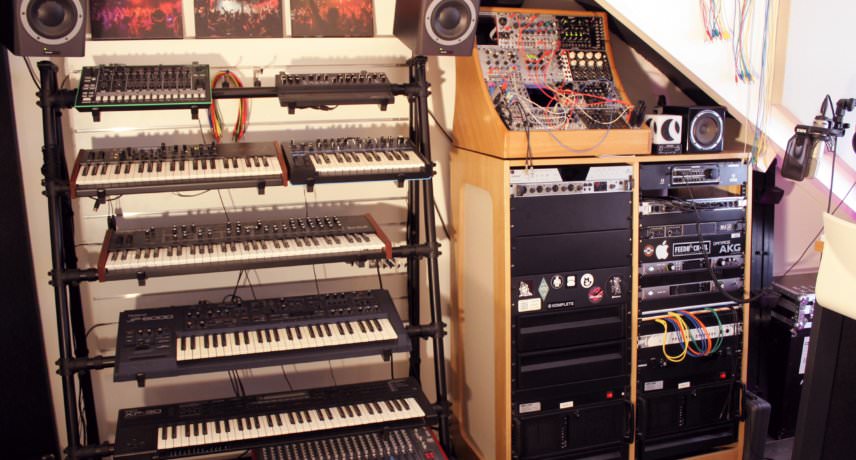


Synths
The synths side is where a lot of my ideas start. Everything is hooked up via the patch bay to my UAD Apollo’s and most of the synths have their own channel. From top left to bottom you can see the Roland TR-8, Stylophone GEN R-8, Dave Smith Mopho X4, Novation Bass Station 2, Dave Smith Prophet REV 2, Roland JP 8000, Roland XP 30, and just below that an Allen & Heath mixer, the Roland Boutiques and a Roland PA 250 mixer. I also mounted a pair of Dynaudio monitors for better sound if I’m working on this side.
Related
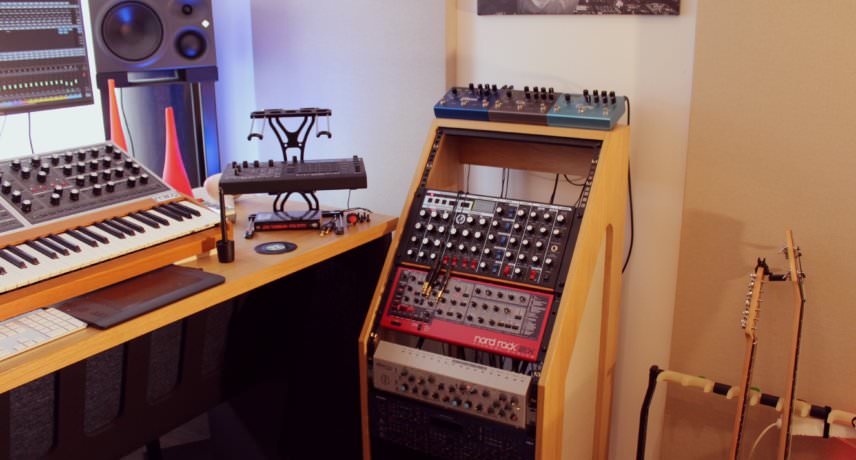


FX
This is my effects corner with 3 Strymon pedals, a Sherman Filterbank 2 and the SRS 56 (currently getting repaired). I also have my Moog Voyager in the rack here, as well as a Nord Rack 2X (which I don’t use that much anymore) and a Novation Supernova 2 (which I only use for the vocoder). I really love the Strymon pedals, I’ve got the Bigsky for reverb, Timeline for delay and the Mobius for modulation. I have the studio set up in such a way that I can route everything through everything. That’s why I love working with the UAD Apollo’s, they compensate for delay automatically. For the first time in as long as I can remember, my entire studio is in sync, whether I’m working with plugins, external effects or a mix of both, everything stays in sync at all times which is pretty amazing!
Related
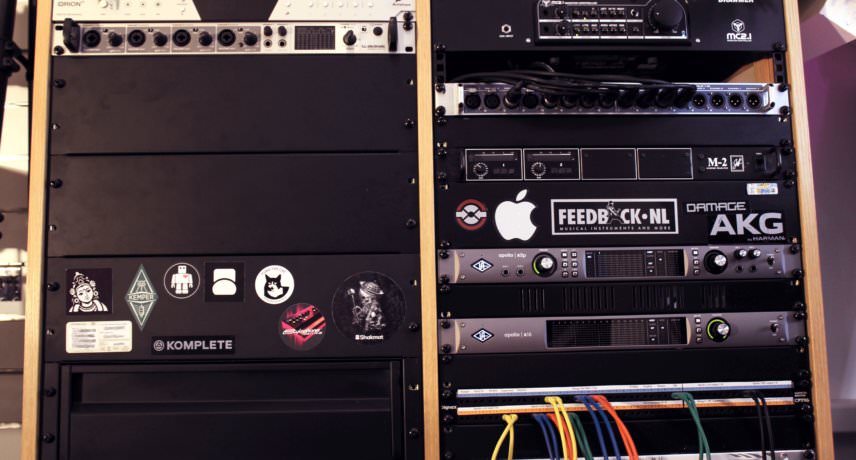


Rack
This is the main studio rack with my UAD Apollo’s, midi interfaces, patch bay, Mic PRE (John Hardy M-2) and a monitor controller. I’m a huge UAD plugin fan, and so besides the two in this picture, I also have an additional 3 Octo’s in case I run into really demanding projects. It also makes running everything from the laptop a breeze, as I rarely use more than 30 or 40% CPU. In case things really need extra power there are two Windows computers in the rack as well, both running Vienna Ensemble on a local gigabit network. But I really only need that when I’m working on music for film or trailers.
Related
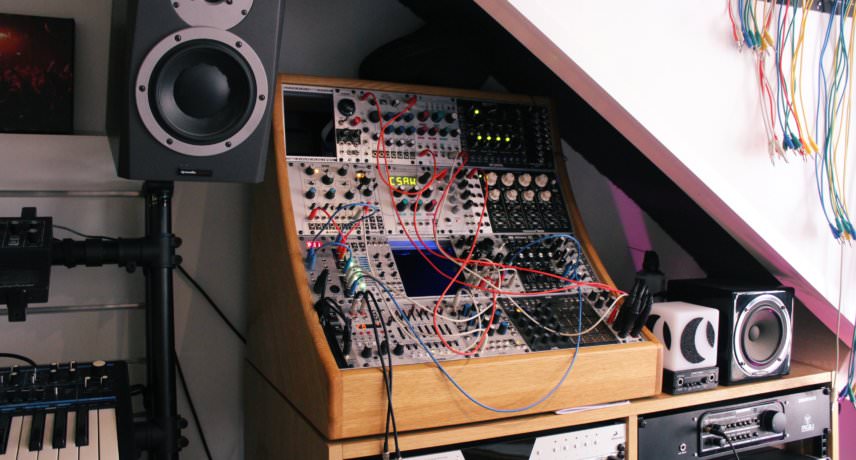


Modular
If I could only choose a single piece of equipment to keep, it would be this one. I started diving into the modular landscape somewhere mid 2016. It has literally changed my entire workflow and inspiration process. Like most people, I started out with a couple of basic modules but the case quickly filled up. The bottom part is the synthesizer section. Here I’ve placed the oscillators, filters, sequencers and everything that I use to come up with melodies. The top row is mostly effects, it has ADAT in / out so I can send up to four stereo tracks to the modular for creative processing, while melodies or bass lines that I create in the bottom section continue playing. I think you can hear my modular on every single track or remix that I have done since 2016. For instance, it’s responsible for the fast paced arpeggiator melody that you hear in ‘De Orde Van De Nacht’ (Part 2) from 2:05 onwards. It’s the bass line that you hear throughout ‘The Hierophant’. It is also the main bass / lead sound in ‘The Magician’ and the main bass in ‘Maschine 2.0’, most noticeably when it goes crazy from 2:37 onwards. It also does the bass / lead sound in ‘Rubicon’, I’ve even named that track after the Rubicon oscillator that was used.
Nowadays I also create all my creative effects and wooshes and risers myself. All those pitch shifting reverbs and delays that you hear in many of my songs (e.g. at the start of ‘The Magician’), they were all done on the modular. I don’t even really use samples anymore, almost every hit or sound gets processed through the modular before I record it back to audio. Some of the aggressive hi-hats that you hear on ‘The Hierophant’ (1:37) were made processing a snare drum with the Clouds grain delay.
I guess I could go on and on, but suffice to say; this is my number one piece of gear I could not live without.
Related
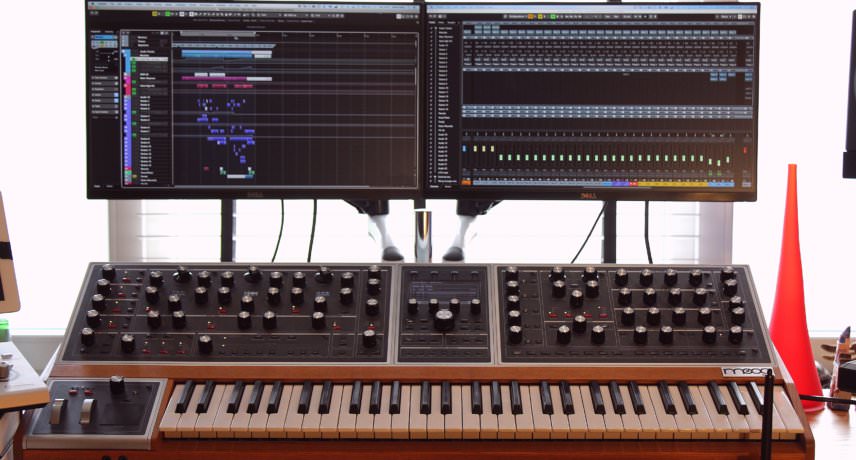


Moog One
I had been on the lookout for a classic poly synth for a while, but had not committed to anything yet. Then Moog announced their One, and I think I was the 3rd of 4th person in the Netherlands to get it. It’s a very interesting machine. It doesn’t have a sweet spot like some of the classics that always sound amazing. The One can sound digital, it can sound harsh, but it can sound warm and incredibly full and alive as well, it is very dependant on how you build your patch. I’ve noticed that I use it mostly for effects, lead sounds and pad sounds, I’m not too keen on the bass it produces. But with the modular and my Moog Voyager and Bass Station, I don’t really need it for bass anyway. I’ve used the One quite a bit on ‘Oscillations’, my next artist album out in September. It’s used in ‘Woodstock’ for both the main pad (0:47) and the main lead sound (2:20). It’s also the main lead in ‘The Hierophant’ (2:03), and I also used it for the aggressive drone / synth at 3:52. It was also featured heavily on my Armin van Buuren – ‘Blue Fear’ (Day Remix) at 1:22 for the LFO type melody, and in my ‘Night’ Remix it did the full detuned lead which I recreated on the One.
I don’t use the One on every track, but it’s a very powerful machine that I love just getting lost in. You can tweak for hours and hours and make snapshots in the meantime, saving all your progress. They really put a lot of work into the user interface. While it doesn’t sound as outrageous as some other synths, it is incredibly good at what it does and I’ve really come to appreciate its character over time.
Related
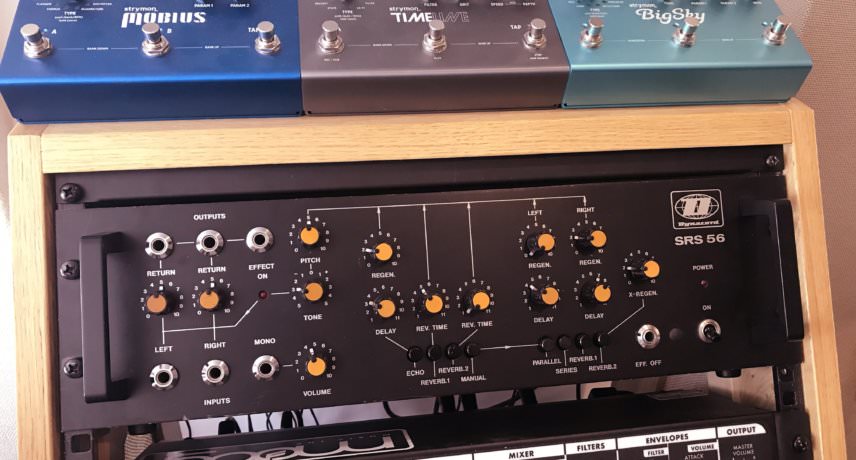


Dynacord SRS 56
I bought the SRS 56 very recently, in May or June of this year. It’s a very rare stereo BBD delay / reverb from the late 70s / early 80s. I had always wanted a real analog delay in my setup. Most of the other delays that I use are either UAD plugins or digital effects such as the Strymon Timeline. The SRS has a very interesting character. In essence, it is a delay unit, but it has a couple of reverb settings as well and mine has been modded for infinite feedback. Soundwise it’s amazing on things like vocals, guitars and arpeggiated melodies. Because it has cross feed and LFO pitch shift, it can go from warm and beautiful right down to alien and otherworldly.
Somehow it manages to occupy a part of the mix that none of my other delays can, without sounding obtrusive or overly present. It’s been featured quite a bit on the new album. For instance, I’ve used it for the vocal processing on ‘Taking Flight’ with Nathan Nicholson (2:26). I also used it for the delay on the main synth on ‘Distance’ (4:16). I had finished that track long before I got the SRS, but one of the things I still wanted to address was the main synth which, no matter how much delay I put on it, still sounded rather dry in the mix. You can also hear it on ‘You’ with Diana Miro at 2:24, it is the delay unit on her backing vocals. Those suffered from the same issue, even though I added more reverb and delay, I still found them somewhat dry in the final mix. The SRS really managed to fix that by adding a type of delay that I can’t get from any of my other units and it doesn’t drown the sound either.
Related
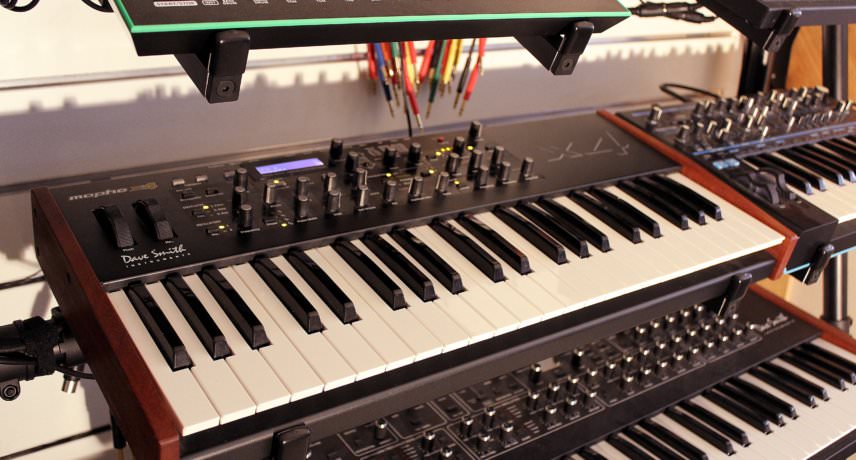


Dave Smith Mopho X4
I ended up buying the Mopho X4 for one of the strangest reasons you’ll ever hear. I had a big hole in my studio desk after selling a mixer / controller, and I really wanted a keyboard back in front of me. The Mopho X4 was the only keyboard that fit perfectly.. I basically bought it for its size, but came to love it for its sound. You easily misjudge this thing just by looking at it. Its power comes from the feedback circuit that feeds its output back into itself. That can vary from just a hint of distortion all the way to full blown ridiculous overdrive. It’s a very recognisable sound as well, I used it for the main bass on The Calling (3:11) for instance. That patch is two saw waves with different glide settings, and so one saw changes notes almost instantly while the other glides to it. That growling quality comes from the feedback circuit. Because it’s such a small and handy synth, I’ve also used it as the main synth / keyboard in my live setup, although I’m currently contemplating switching to a MIDI keyboard because I’d rather not damage the Mopho now that it’s not available anymore.
Related



Roland PA 250
I came across this mixer just randomly browsing a Facebook studio gear group that I am part of. I did not know it before then, but it drew my attention because it has a real spring reverb built-in. I love the sound of spring, and before the PA 250 I only owned digital recreations. I basically bought it without reference, but what I was hoping for was maybe setting it up as a send return from my DAW and spicing up some cold and lifeless sounds. Turns out that I was right!
It’s set up in such a way that I am always driving the gain circuit and there’s always a bit of spring and EQ on everything that I send through. It’s especially amazing on drum loops, I hate going through all those cold and sterile sample libraries with countless loops, but previewing them through this thing is a joy. It just adds life to everything you throw at it. Don’t expect squeaky clean, it’s noise, dirt and hum, but that is exactly what I love about it. I’ve used it on a couple of tracks on the new album. For instance, the bass line in Control was sent through it in its entirety. You can hear the spring quite well right at the start of the tune when the bass fades in, and you can hear the noise and spring fade out right at the end at 5:43. I also used it for all the rhythm parts in Tide. They come in at 1:48.
Because it adds a bit of noise and low-frequency hum every time you send something through it, I prefer to send a couple of tracks at once, once they are mixed well. You don’t want all of that noise adding up. I don’t think it’s the most versatile piece of gear that I own, but you can’t really put a price on inspiration, and that’s one thing that the PA 250 does really well!
Related



Overview
I built my current studio into the attic of my house back in 2016. After struggles with RSI and neck issues, I changed the whole setup into a standing workspace. I thought about having a desk that moves, but it just seemed too much of a hassle with speakers and cables having to move as well, so instead I added a custom height bar stool and I alternate between standing up and sitting down. I also changed to a mobile setup a few years back, so I am now running everything from a Macbook Pro. When I’m travelling I can work on tracks on the go, and at home, it goes into a thunderbolt dock and I can work with all my external gear. Even though you don’t really see it, a lot of acoustics went into this space. There are 3 room height bass traps behind me, and the entire ceiling is cloth with treatment behind it. Together with the panels that are left and right of my listening positions, the room sounds remarkably balanced and neutral for its size. I’ve always found acoustics extremely important, I can’t work at all if the sound is no good.
Related
‘Oscillations’ is available digitally and on vinyl.
Find Eelke Klein on Facebook and Instagram.
Main photo by Walter Paz.
Related
25th September, 2020
